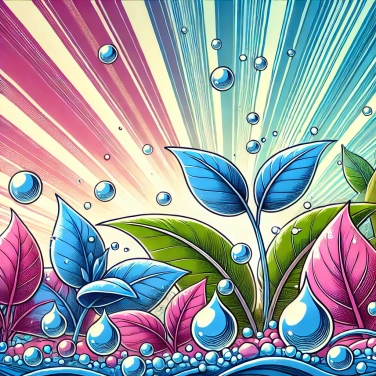Some plant leaves are hydrophobic because they have a thin layer of wax on their surface, which repels water and allows the plant to resist moisture and promote water flow without getting wet.

You have probably noticed that water forms nice round drops on some leaves rather than spreading out. This phenomenon is mainly explained by the surface tension of water and the particular nature of the surface of the leaves. Water molecules love to stay grouped together, creating a kind of resistant "skin" around the drops; that's surface tension. Many leaves have a surface covered with fine microscopic structures like a mini forest of tiny spikes or hairs. Imagine placing a ball on a tightly packed bed of nails: it barely touches the surface, just like the water drop. With a reduced contact area, the water adheres less and quickly rolls off the leaf, often cleaning dirt along its path. This mechanism has a nice name: the lotus effect, referring to this plant known for keeping its leaves always clean and dry thanks to these physical tricks.
The surface of hydrophobic leaves is primarily covered by an outer layer called the cuticle, which is rich in fatty substances known as cuticular waxes. These waxes are mainly composed of molecules called long-chain hydrocarbons, as well as other compounds like fatty acids and fatty alcohols, all of which are very poorly soluble in water. This waxy layer literally prevents water droplets from adhering, causing them to easily roll off the leaf without actually wetting it. Some plants even have compounds called epicuticular wax crystals, which further enhance the hydrophobic effect. The more abundant the wax and the more suitable its chemical composition, the more effective the surface becomes at repelling water.
On many plant leaves, there are tiny hairs called trichomes, as well as small bumps and very fine grooves. These small structures create a rough surface at the microscopic scale. When a drop of water lands on it, it actually rests on the peaks of these tiny irregularities, without really touching the leaf deeply. Since the water is in contact only at a few points, it hardly attaches: as a result, it glides or rolls right off the leaf. This is exactly the same principle found in the lotus flower, known for remaining dry even after heavy rain, a phenomenon known as the lotus effect.
Some plants have hydrophobic leaves to limit water accumulation. This helps them stay clean by removing dust, spores, and pathogens through a "self-cleaning" effect. In humid environments, it completely prevents the development of dangerous microorganisms. When it rains heavily, the water-repellent leaves perform better: they are less weighed down by water, thus reducing the risk of breakage or damage. They also enhance their resistance in times of drought because by repelling droplets, the plant reduces unnecessary water loss and can therefore better manage its water reserves. Overall, a hydrophobic leaf is better protected, resilient, and suited to very humid or unpredictable climates.
Hydrophobic leaves limit the accumulation of water on their surface by forming droplets that slide off quickly. This reduces the prolonged presence of liquid and thus prevents the stomata (small pores responsible for gas exchange) from becoming blocked. As a result, gas exchanges, necessary for respiration and photosynthesis, are maintained even after rain. However, in terms of water, these leaves absorb almost no water through their surface. Therefore, all their water supply must come exclusively from the roots, which requires a very efficient root system. A gain in terms of respiration, but an additional constraint for water supply.
The microstructure responsible for the hydrophobicity of a leaf is often composed of a combination of specific waxes and tiny hairs or textures, invisible to the naked eye, but working together as a genuine barrier against water.
Did you know that a leaf that has lost some of its hydrophobicity often indicates environmental stress or a deterioration of its protective layer? It’s a good indication to monitor the health of your garden plants!
Thanks to their hydrophobic properties, some plants reduce the proliferation of fungi and other pathogenic microorganisms, allowing them to maintain better overall health!
Water droplets on certain highly hydrophobic leaves, such as those of kale, take on a nearly perfect spherical shape, which limits contact with the surface and thus facilitates their rapid movement on the plant.
Yes, it is possible to artificially modify the surface of a leaf using specific chemical or biological coatings. However, these methods are generally not suitable for natural or ecological use, as they can disrupt the physiological processes of the plant.
No, the hydrophobicity of leaves is not a universal characteristic among plants. Some species develop hydrophobic surfaces as a specific adaptation to their environment, while others have hydrophilic or neutral leaves.
Hydrophobic leaves promote natural cleaning of surfaces (lotus effect), limit microbial growth on the leaf, reduce the risk of infections, and minimize water accumulation that could encourage fungal growth.
No, on the contrary, hydrophobicity often protects leaves from contaminants, dust, and pathogens. By keeping these elements away, it allows for better exposure of the leaf surface to light, thereby promoting photosynthesis.
A hydrophobic surface is one that repels water, causing the formation of round droplets that slide off easily. A hydrophilic surface, on the other hand, is attracted to water and promotes its complete spreading over the surface.

0% of respondents passed this quiz completely!
Question 1/5